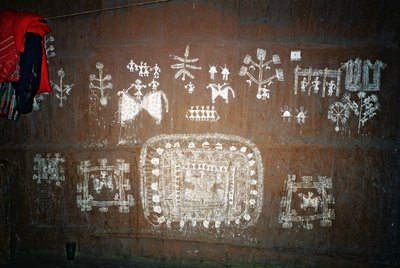Warli Tribe (english)

Sacred Moutain, Warli area, 2003.
WARLI TRIBE
MAHARASHTRA
Based in the Thane District, about 150 km north of Bombay, the Warli tribe numbers over 300,000 members. They have their own beliefs, life and customs which have nothing in common with Hinduism. The Warli speak an unwritten dialect mingling Sanskrit, Maharati and Gujarati words. The word « Warli » comes from «warla» which means a piece of land or a field. In his book, The Painted World of the Warlis, Yashodara Dalmia claimed that the Warli carry on a tradition stretching back to 2 500 or 3 000 BC. Their mural paintings are similar to those done between 500 and 10 000 BC in the Bhimbekta caves, in Madya Pradesh.
"Cauk" ritual painting on wall, Thane District, 1998.
 "Cauk" ritual painting on wall, Thane District, 1998.
"Cauk" ritual painting on wall, Thane District, 1998.
Their extremely rudimentary wall paintings use a very basic graphic vocabulary: a circle, a triangle and a square. The circle and triangle come from their observation of nature, the circle representing the sun and the moon, the triangle derived from mountains and pointed trees. Only the square seems to obey a different logic and seems to be a human invention, indicating a sacred enclosure or a piece of land. So the central motive in each ritual painting is the square, the cauk (or caukat); inside it we find Palaghata, the mother goddess, symbolizing fertility.
Woman painting with bamboo stick on paper.

Young girls coming to the most important Warli Festival.
Significantly, male gods are unusual among the Warli and are frequently related to spirits which have taken human shape. The central motif in these ritual paintings is surrounded by scenes portraying hunting, fishing and farming, festivals and dances, trees and animals. Human and animal bodies are represented by two triangles joined at the tip ‹ the upper triangle depicts the trunk and the lower triangle the pelvis.
Their precarious equilibrium symbolizes the balance of the universe, and of the couple, and has the practical and amusing advantage of animating the bodies. Without this balance, Warli art would be devoid of rhythm and life. The pared down pictorial language is matched by a rudimentary technique. "Cauk" acrylic on paper, 1998.
"Cauk" acrylic on paper, 1998.
The ritual paintings are usually done inside the huts, which measure about 8 by 6 meters and seldom have partitions. A symbolic separation shares the space between people and cattle. The walls are made of a mixture of branches, earth and cow dung, making a red ochre background for the wall paintings. The Warli use only white for their paintings. Their white pigment is a mixture of rice paste and water with gum as a binding. They use a bamboo stick chewed at the end to make it as supple as a paintbrush. The wall paintings are done only for special occasions such as weddings or harvests. The lack of regular artistic activity explains the very crude style of their paintings, which were the preserve of the womenfolk until the late 1960s. But in the 1970s this ritual art took a radical turn.
A man, Jivya Soma Mashe started to paint, not for any special ritual, but on an everyday basis. His talent was soon noticed, first nationally then internationally, bringing unprecedented recognition, which prompted many other young men to follow suit.
Hervé Perdriolle. (in Tribals Art magazine, September 2001)
Paintings on paper and wall, Thane District, 1999.
----------------------------------------------------------------------
Copyright textes, photos et collection : Hervé Perdriolle

